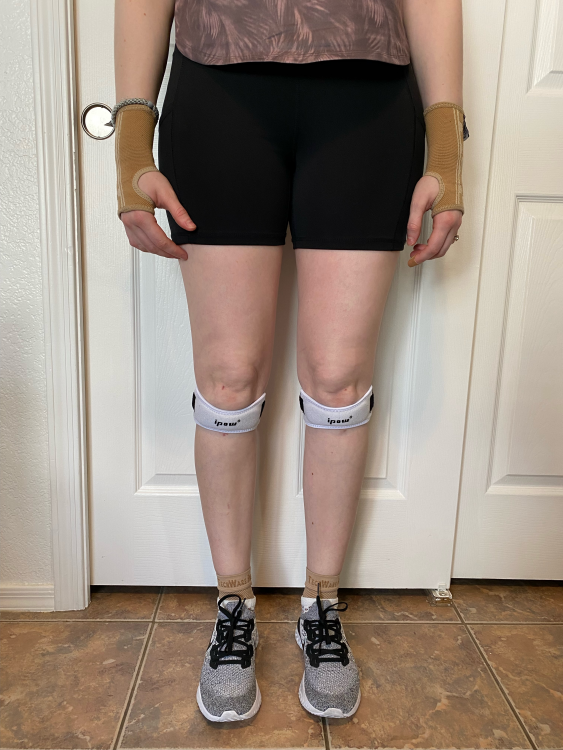Exercise is super important, but most of us with chronic illness don’t partake (at least not to the extent we should).
I have recently gotten in the habit of exercising a few times a week, and honestly: it’s a game changer.
• What is Ehlers-Danlos Syndrome?
• What Are Common Ehlers-Danlos Syndrome Symptoms?
I want to start off with some important caveats:
- What works for me isn’t necessarily going to work for everyone. We all have different bodies, personalities, and lifestyles. That being said, many of these tips should be broad enough to apply to many different situations and people.
- I am not a physical therapist, personal trainer, or other professional. These are simply things I have learned along my (admittedly short) fitness journey. Depending on your situation, it might be worth consulting with a professional to get you started.
- I want to emphasize that physical activity/exercise/fitness can be incredibly broad. It doesn’t have to be on a treadmill at a gym. My fellow spoonies love swimming, aerial yoga, rock climbing, using a gaming console… try a few to see what works for you.
Regardless of what activity you choose, tackle these questions to be mentally, emotionally, and physically ready to take on this change.
WHO: Do you want to work out alone? Do you want an accountability partner?
- This will likely depend on your personality — I think there are benefits either way.
- I think having an accountability partner, even if they don’t work out with you, is beneficial.
- If you choose to work out with someone, you don’t have to do the same exercises the whole time. You can join up partway through or just at the end to stretch/cool down.
WHAT: Which activities/exercises are you actually going to do?
- Unless you are starting with a fitness class, you will have to figure out what actual movements you want to do during your fitness time.
- There are lots of clever solutions for this. There are apps that will assign exercises, flows on Pinterest, flashcards, books, dice etc.
- This is where you will have to do your own research to personalize your time to fit your needs.
- Be reasonable about the number of exercises you fit in based on the time you allot.
- You can be spontaneous if you would like.
- However, when I personally try to do this, I spend a lot of my workout time looking for inspiration rather than actually working out.
- I advise at least a vague idea of what you want to do — “yoga,” “arms,” “cardio”, etc. to guide you.
- Make sure you have a warm-up and cool-down period.
WHEN: Think about timing in the day, day(s) of the week, etc.
- Humans do best with a routine. You will likely be the most consistent (I.e. successful) if you set up your calendar to always work out at the same time on the same days.
- Personally, I found that I need to leave my house to work out. At home, I am too likely to procrastinate or entirely skip. If I get myself to the gym, I am already committing to doing the work.
- Know yourself. Take into account what times/days are most convenient, but also when you are freshest.
- If you are a night owl, early morning exercise is not likely to be successful.
- If your pain or other symptoms get worse throughout the day, a late workout is probably unrealistic.
- Start slow.
- For example, once or twice a week for 30 minutes will be enough to get you in the habit.
- You can always go longer if you are feeling motivated.
- It is best to have at least a day of rest in between exercise days, especially in the beginning.
- For example, once or twice a week for 30 minutes will be enough to get you in the habit.
WHERE: Most importantly, you need a place where you can focus on your exercise.
- Home can feel more comfortable and non-judgmental. But it can also be more distracting and more limited.
- Weigh the pros and cons for you.
- As you progress in your fitness journey, this may change.
- Gyms can feel judgmental, but not all of them are.
- If you are thinking of joining a gym, be sure to take a tour. You will get a good sense of whether the vibe is right for you.
- If you are running/biking/walking etc. around your neighborhood, make sure you know the area well or have a map in some form.
- Make sure you wear reflective gear, especially at night.
WHY: This is the most important part of your exercise preparation. Going to the gym with the wrong motivation or vague goals won’t be as successful.
- Make your goal SMART. If you don’t know what those are, you can learn more here. Basically, having a SMART goal makes it more likely you will be successful.
- Specific: “Get fit” or “work out” are not specific goals.
- Do you want to get stronger? More flexible? Maybe you just want to be more physically active.
- Measurable: You want to be able to put a number to your success.
- This doesn’t mean it needs to be a physical measurement like pounds, inches, or BMI (which is a terrible measurement).
- It could be #_ reps of an exercise, #_ seconds holding a pose, or #_ minutes of cardio.
- Achievable: Do a reality check.
- You may need to adjust your goal after your first session, and that’s OK.
- You want your goal to be on “the high side of reasonable.” That is, you want a challenge, but you want it to be motivating, not deflating.
- Relevant: This seems obvious. It emphasizes making sure your goal matches the type of exercise you choose.
- For example: If you are going to do yoga, don’t try to measure how much weight you can lift as a result.
- Time-bound: Give yourself a specific amount of time to achieve your goal.
- This then gives you the ability to evaluate how you progressed and create a new goal.
- Reward yourself if you achieve your goal! A new workout outfit, new gear, a coloring book… whatever motivates you.
- Give yourself grace if you don’t achieve your goal. Physical activity will benefit you even if the progress isn’t as fast or as smooth as you want.
- Specific: “Get fit” or “work out” are not specific goals.
HOW: Prepare for potential problems before they occur.
- You will likely feel ridiculous, out of shape, like quitting, and/or out of place at least once in the first few weeks. Think through some encouraging self-talk you can pull out of your back pocket.
- There are some exercises that look ridiculous by nature. There are some machines that are not graceful to enter or exit; that’s not specific to you. Keep that in mind too!
- If you are a competitive or self-conscious person (*cough* me *cough*), you will feel the need to compete and/or compare yourself with
- 1) those working out around you
- 2) the fitness model displaying the exercise
- 3) your friend on Facebook who posts gym selfies
- 4) literally any human being.
- Prepare strategies to minimize this.
- Own anything that might be “embarrassing.” For example, I have Ehlers-Danlos syndrome, meaning my joints hyperextend; I wear braces to counteract this. It’s not my favorite stylistic choice, but it makes exercise manageable. Try to worry about what is going to make you successful, not what you look like (I know, easier said than done).

Hopefully, these tips inspire you to start some kind of physical activity!
This article is part of a series on Exercising With Chronic Illness. Read more here:
This story originally appeared on Paiges of Progress.

